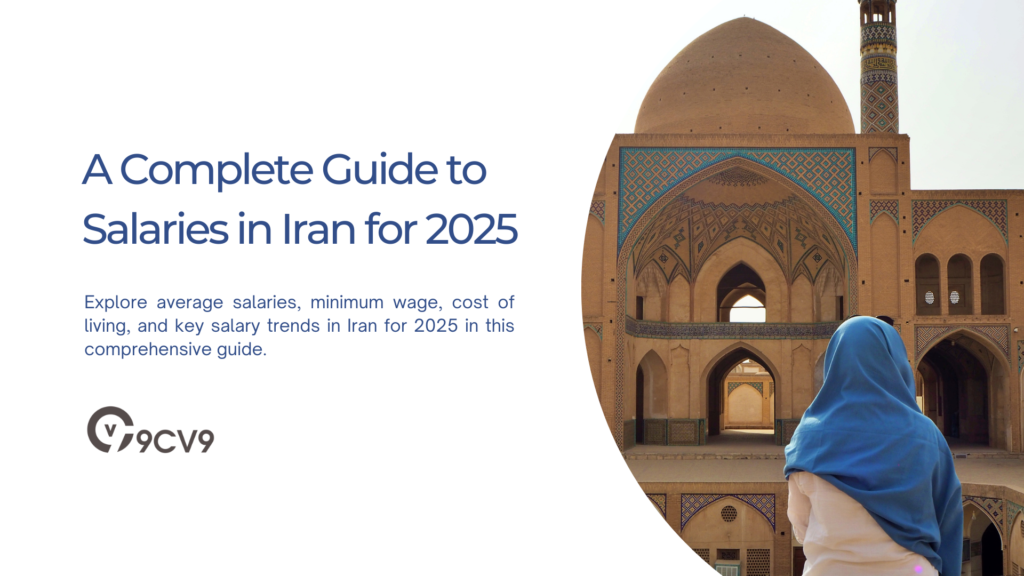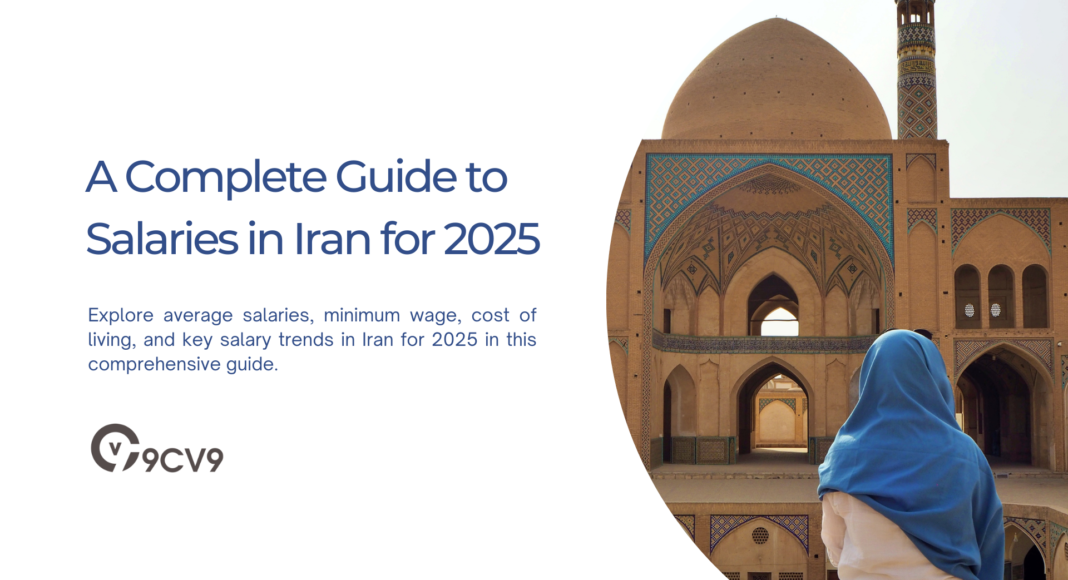Key Takeaways
- Iran’s average annual salary in 2025 is approximately 537,600,300 IRR, with wide income disparities across industries and sectors.
- Minimum wage rose over 46% in 2025 but still falls short of covering basic living expenses, especially in cities like Tehran.
- Exchange rate volatility and inflation significantly impact real wages, making accurate salary comparisons reliant on market-based currency rates.
Understanding salary trends is essential for anyone considering employment, relocation, or business expansion in Iran.
Whether you’re a local job seeker, a foreign investor, a business owner, or a global HR professional looking to hire Iranian talent, having access to accurate and up-to-date salary information is crucial.
With the Iranian economy undergoing continuous transformation amid geopolitical shifts, economic reforms, currency fluctuations, and technological advancements, the structure of wages and compensation in the country is evolving rapidly.
Also, read our top guide on the Top 10 Best Job Posting Websites in Iran in 2025.

This guide provides a comprehensive overview of salaries in Iran for 2025, helping you navigate the complexities of income distribution, job market demand, and compensation expectations across various sectors.
Iran, as one of the largest economies in the Middle East, boasts a diverse and dynamic labor market.
From oil and gas, healthcare, education, and IT to manufacturing, retail, and agriculture, the range of career opportunities is broad and varied.
However, understanding the average income, minimum wage regulations, regional salary disparities, and sector-specific earnings is not always straightforward.
Factors such as inflation, international sanctions, government subsidies, exchange rate volatility, and cost of living changes all play a role in shaping salary trends.
In 2025, Iran’s job market is influenced by several key trends: the growing digital economy, rising youth unemployment, a skilled labor shortage in certain high-tech industries, and continued efforts to localize production and reduce economic dependence on imports.
Also, read our top guide on the Top 10 Best Recruitment Agencies In Iran for 2025.
These dynamics significantly impact wage levels, employee benefits, and employer expectations. Additionally, with the rial experiencing ongoing devaluation and high inflation, it’s important to analyze salaries both in local currency and in USD or other benchmarks to gain meaningful insights.
This guide will delve deep into salary benchmarks by industry, job titles, experience levels, education, and geographic location.
It will also explore gender pay gaps, public vs. private sector wages, and the impact of freelancing and remote work trends on earnings in Iran.
We will also highlight the expected salary growth projections, bonus structures, in-demand skills, and employment benefits that shape the total compensation package for workers in 2025.
Whether you are trying to negotiate a job offer, set a competitive salary for your team, or simply want to understand how much people earn in Iran today, this detailed guide is designed to provide clarity and actionable insights.
By the end of this article, you’ll have a solid understanding of what to expect when it comes to wages in Iran—and how to interpret the numbers within the broader economic and social context of the country.
Let’s explore everything you need to know about salaries in Iran in 2025.
Before we venture further into this article, we would like to share who we are and what we do.
About 9cv9
9cv9 is a business tech startup based in Singapore and Asia, with a strong presence all over the world.
With over nine years of startup and business experience, and being highly involved in connecting with thousands of companies and startups, the 9cv9 team has listed some important learning points in this overview of Salaries in Iran.
If your company needs recruitment and headhunting services to hire top-quality employees, you can use 9cv9 headhunting and recruitment services to hire top talents and candidates. Find out more here, or send over an email to [email protected].
Or just post 1 free job posting here at 9cv9 Hiring Portal in under 10 minutes.
A Complete Guide to Salaries in Iran for 2025
- Economic Context: Understanding the Foundation of Salary Trends in Iran (2025)
- General Salary Trends in Iran in 2025: An Aggregate Analysis
- Industry-Specific Salary Analysis in Iran for 2025
- Public Sector Salaries in Iran in 2025: A Comprehensive Overview
- Minimum Wage in Iran in 2025: Economic Realities and Social Implications
- Cost of Living in Major Iranian Cities in 2025: A Comprehensive Overview
- Key Factors Influencing Salary Levels in Iran in 2025
- Evaluating the Reliability of Salary Data Sources in Iran (2025)
- Currency and Exchange Rate Considerations for 2025
- Overview of Salary Trends in Iran in 2025
1. Economic Context: Understanding the Foundation of Salary Trends in Iran (2025)
In 2025, Iran’s economy presents a highly complex and challenging environment, shaped by both longstanding structural issues and recent economic shocks. These underlying macroeconomic factors have a direct influence on wage levels, purchasing power, and employment opportunities across the country.
- Macroeconomic Instability
- Iran is undergoing a period of economic instability marked by volatile market conditions, high inflation, and limited GDP growth.
- Structural weaknesses, compounded by persistent international sanctions, have impeded economic reform and industrial diversification.
- Currency devaluation and rising import dependency have further intensified the cost of living crisis.
- Impact on Salaries
- These macroeconomic pressures have severely constrained the ability of employers—both public and private—to raise wages in line with inflation.
- Real wages (adjusted for inflation) continue to decline, despite nominal increases in many sectors.
Inflation and Its Consequences on Wages
One of the most defining characteristics of Iran’s current economic condition is the extraordinarily high and sustained rate of inflation.
- Chronic Inflation Trends
- Annual inflation has consistently exceeded 30% since 2018.
- In early 2025, core inflation for essential goods reached above 50%, particularly affecting food, fuel, and household necessities.
- Erosion of Real Income
- Workers receiving salary increases often see these gains offset or entirely erased by surging prices.
- The cost of basic needs—such as housing, healthcare, and groceries—has significantly outpaced wage growth.
- Households increasingly rely on multiple income sources or informal work to meet basic living standards.
Limited Economic Growth and Its Impact on Salary Structures
Despite the need for income improvements, Iran’s economy shows limited capacity to support substantial wage increases.
- Minimal GDP Growth
- Forecasts indicate that Iran’s inflation-adjusted GDP growth for the Persian calendar year ending March 2025 will barely reach 2%.
- Economic expansion remains sluggish due to limited foreign investment, technological stagnation, and production inefficiencies.
- Business Constraints
- Many businesses report shrinking profit margins, making it difficult to raise employee salaries competitively.
- Recruitment is often restricted to essential roles, with limited flexibility for salary negotiations or bonuses.
Currency Devaluation and International Salary Comparisons
The depreciation of the Iranian Rial has created additional hurdles for wage earners, particularly in sectors with international exposure or import dependency.
- Exchange Rate Volatility
- In the 12-month period ending January 2025, the Rial lost 62% of its value against the US Dollar.
- By April 2025, the open market exchange rate crossed 1,000,000 IRR per USD, marking a historic low.
- Consequences for Salaries
- Salaries, when converted to international currencies, are significantly devalued, reducing the attractiveness of Iranian jobs to foreign workers or expatriates.
- For businesses relying on imported goods and raw materials, rising costs further erode the feasibility of offering competitive wages.
- Increased Cost of Imports
- Imported food, medicine, technology, and fuel have become prohibitively expensive.
- The weakening of the Rial contributes directly to inflation, intensifying the gap between wage growth and the cost of living.
Sanctions and Global Isolation: Constraints on Wage Growth
Economic sanctions remain a persistent and detrimental force, limiting Iran’s access to capital, technologies, and global markets.
- Restricted International Trade
- Sanctions prevent integration into global financial systems and restrict access to foreign investment.
- As a result, sectors such as finance, oil, aviation, and automotive manufacturing operate with severe constraints.
- Implications for Employment
- Employers in sanctioned industries have limited liquidity and often cannot afford wage increases, job expansion, or benefit packages.
- Skilled professionals frequently seek employment abroad or shift to freelance and gig work in order to bypass local economic limitations.
Public Sector Wages: Budget Allocations and Government Priorities
A closer look at the national budget offers key insights into salary planning within Iran’s public sector in 2025.
- Budget Analysis
- Government spending priorities have increasingly focused on security, ideological institutions, and state broadcasting.
- The public sector wage budget was increased by only 20%, substantially below the national inflation rate.
- Real-World Consequences
- Teachers, healthcare workers, and civil servants face declining real incomes despite nominal raises.
- Public dissatisfaction with wage stagnation has led to increased protests and calls for economic reform.
Labor Market Dynamics and Workforce Participation
Despite high unemployment and widespread underemployment, Iran is experiencing a counterintuitive labor shortage.
- Labor Market Paradox
- Many Iranians, particularly youth and women, remain unemployed or underemployed not due to lack of job availability, but because available jobs offer unsustainable wages.
- The informal economy has become a crucial safety net, providing more flexible, albeit unstable, income sources.
- Migration and Brain Drain
- Talented professionals continue to seek opportunities abroad due to low wages and limited career progression.
- This exacerbates domestic labor shortages in key sectors such as healthcare, IT, and engineering.
Conclusion: The Context Behind Compensation in Iran
The Iranian salary landscape in 2025 cannot be understood in isolation. It is intricately tied to broader economic forces—both internal and external—that affect inflation, purchasing power, business profitability, and public sector decision-making. As the country continues to navigate currency crises, sanctions, and evolving geopolitical pressures, salary trends will remain highly sensitive to these factors. Understanding these complexities is essential for anyone assessing employment opportunities, managing payroll, or conducting wage benchmarking within Iran’s evolving economic environment.
In the following sections of this guide, a detailed breakdown of salaries by sector, job title, experience level, and location will provide a clearer picture of how these economic conditions translate into real-world income levels across Iran.
2. General Salary Trends in Iran in 2025: An Aggregate Analysis
Understanding general salary trends is essential when evaluating the Iranian job market in 2025. Due to the country’s complex economic conditions—such as persistent inflation, currency volatility, and sectoral disparities—salary data must be interpreted within a broader financial and socio-political context. This section provides a detailed examination of average compensation figures, income distribution, gender pay gaps, and international comparisons, offering valuable insights into the earning potential of the Iranian workforce.
National Average Salary Figures: Contextualizing Compensation
- Reported Average Annual Salary
- As of 2025, the average annual salary in Iran is estimated at approximately 537,600,300 IRR.
- This figure serves as a broad national benchmark but must be viewed with caution due to inflationary pressures and the declining value of the Iranian Rial.
- Impact of Inflation and Devaluation
- Although nominal wages have increased in many sectors, real income (adjusted for purchasing power) has often declined.
- Currency devaluation against the US Dollar reduces the global value of local salaries, significantly affecting international comparisons and expatriate compensation packages.
Salary Distribution Across the Workforce
- Income Range and Variability
- Salaries in Iran span a wide spectrum, with most falling between 135,600,300 IRR and 1,200,000,000 IRR annually.
- This large variation reflects significant income inequality and is influenced by:
- Industry type and market demand
- Level of education and expertise
- Geographic region (urban vs. rural wage differences)
- Size and structure of the employing organization (public, private, or international)
- High-Income Segments
- Senior-level professionals, executives, and technical experts in high-demand fields such as IT, oil and gas, and medicine may earn at or above the upper end of the national range.
- Low-Income Groups
- Entry-level employees, unskilled laborers, and those in informal or part-time work often earn salaries near the lower threshold, especially outside major metropolitan areas.
Gender Pay Disparities: A Persistent Challenge
- Overall Gender Pay Gap
- Across the Iranian workforce, men earn approximately 11–12% more than women on average.
- This gap exists across various sectors and is not limited to isolated roles or industries.
- Illustrative Examples by Profession
- Physicists
- Males: ~1,235,999,900 IRR annually
- Females: ~1,113,601,700 IRR annually
- Gender Gap: ~11%
- Economists
- Males: ~934,798,400 IRR
- Females: ~842,398,300 IRR
- Gender Gap: ~11%
- Administrative Law Judges and Clerical Roles
- Consistent trends show lower earnings for women, even in roles with comparable qualifications and responsibilities.
- Physicists
- Structural Causes
- The gender gap may stem from:
- Occupational segregation
- Limited access to high-paying roles
- Disparities in career progression opportunities
- Discriminatory wage practices
- The gender gap may stem from:
Historical and International Comparisons
- Reference to Historical Salary Benchmarks
- In 2010, the average net salary in Iran was around $708.33 USD per month.
- Although historical exchange rate data is limited, the severe depreciation of the Rial suggests that the real dollar value of salaries in 2025 is significantly lower than it was 15 years ago.
- Current USD Equivalents
- Based on an April 2025 market exchange rate of approximately 900,000 IRR/USD, the national average salary of 537,600,300 IRR translates to roughly $600 USD/month.
- This stark difference from the 2010 benchmark indicates a major reduction in international purchasing power for the average Iranian worker.
- Conflicting Data from Alternate Sources
- Some sources report much higher average salaries, such as $5,453 USD per month—a figure that vastly exceeds what is suggested by most domestic data.
- This discrepancy may result from:
- Inclusion of high-income expatriate salaries
- Sector-specific averages (e.g., oil executives, tech consultants)
- Methodological differences in data collection
- These inconsistencies highlight the importance of critically evaluating salary data sources and understanding the context behind the numbers.
Key Takeaways for 2025 Salary Interpretation
- Nominal vs. Real Salaries
- It is essential to distinguish between nominal income (unadjusted figures in IRR) and real income (purchasing power after accounting for inflation and currency devaluation).
- Income Inequality
- Income distribution is highly uneven, with gaps influenced by industry, gender, and geography.
- Importance of Data Contextualization
- Salary figures must be interpreted in light of:
- Current exchange rates
- Sectoral variances
- Local cost of living
- Macroeconomic conditions
- Salary figures must be interpreted in light of:
- Informed Salary Assessment
- For job seekers, employers, and investors, understanding aggregate salary trends provides a foundational layer before delving into occupation-specific compensation data, which will be explored in the next section of this guide.
3. Industry-Specific Salary Analysis in Iran for 2025
An accurate understanding of salaries in Iran for 2025 requires a sector-by-sector breakdown, as compensation varies significantly between industries. Factors such as international demand, sectoral growth, labor shortages, and local market dynamics influence the earning potential in each field. While salary data for some industries remains limited or fragmented, available insights offer a helpful snapshot of key trends in Iran’s job market for 2025.
Technology and Information Sector: High Demand, Global Reach
The technology and IT industry continues to be one of the most dynamic and globally integrated sectors in Iran.
- Software Engineering Salaries
- Average annual salary for a Software Engineer: approximately $68,404.
- Salary range: $24,000 to $120,000 annually.
- Salary differentials are influenced by:
- Experience level (junior, mid-level, senior)
- Specialization (e.g., backend development, cybersecurity, data science)
- Employer type (domestic vs. multinational or freelance/remote work with foreign clients)
- Impact of Remote Work and Globalization
- Iranian software professionals increasingly engage with international tech companies through remote freelance platforms.
- This trend allows skilled professionals to earn foreign currency, bypassing local currency devaluation challenges.
- Business and IT-Adjacent Roles
- Monthly salaries in USD (based on unspecified exchange rates but indicative of relative hierarchy):
- Financial Manager: ~$2,129
- General Manager: ~$1,935
- Business Development Manager: ~$1,840
- Financial Analyst: ~$1,388
- Business Analyst: ~$1,405
- Project Manager: ~$1,257
- These roles typically require experience in strategic planning, operations, and finance, and are often employed within tech-driven enterprises.
- Monthly salaries in USD (based on unspecified exchange rates but indicative of relative hierarchy):
- Key Takeaways
- The tech sector stands out for its comparatively high salaries.
- Skill specialization, English proficiency, and global networking strongly affect earning potential.
- Professionals with internationally recognized certifications or remote work experience command higher compensation.
Manufacturing and Industrial Sector: Data Gaps Amid Operational Challenges
Although manufacturing remains an important segment of the Iranian economy, detailed wage data for this sector in 2025 is lacking.
- Data Availability
- No verifiable salary statistics were found for industrial or factory workers in 2025 within Iran.
- Available research tends to focus on regional or international manufacturing wage trends, which do not accurately reflect local conditions.
- Contextual Considerations
- The manufacturing sector in Iran includes automotive production, machinery, consumer goods, and construction materials.
- Challenges impacting wage growth in this sector:
- Import restrictions and supply chain disruptions due to sanctions
- Rising costs of imported raw materials
- Reduced capital investment in modern equipment and labor training
- Speculated Salary Patterns
- Workers in this sector are likely to earn closer to the lower-middle range of the national average, especially in traditional industries with limited automation.
- Skilled technicians and engineers may receive higher wages, particularly in export-focused manufacturing enterprises.
Oil and Gas Sector: Strategically Critical, But Opaque in Salary Reporting
As the cornerstone of Iran’s economy, the oil and gas sector plays a vital role in national revenue. However, compensation data for employees in this industry remains elusive for 2025.
- Lack of Transparent Compensation Information
- Available literature emphasizes production levels and geopolitical developments, rather than employee salaries.
- The dominance of state-owned enterprises (SOEs) may contribute to a lack of publicly disclosed wage data.
- Sector Characteristics
- Jobs in this field range from field engineers and refinery technicians to geologists and administrative staff.
- Compensation levels are expected to be relatively high for:
- Technical experts with offshore or upstream experience
- Employees with international oil company (IOC) experience or education abroad
- Observations and Assumptions
- Due to the strategic nature of this industry, many high-level roles may include non-salary compensation such as housing allowances, fuel subsidies, and healthcare benefits.
- Salaries are likely more stable than in other sectors, although real wages are affected by inflation and Rial devaluation.
Services Sector: Diverse Roles, Limited Salary Insights
The services sector encompasses a broad array of industries, yet available data on salaries in this domain within Iran for 2025 is sparse.
- Lack of Specific Salary Figures
- No concrete 2025 data is available for Iranian-based roles in:
- Retail and hospitality
- Transportation and logistics
- Banking and financial services
- Tourism and entertainment
- Public administration and education
- No concrete 2025 data is available for Iranian-based roles in:
- Relevance of the Sector
- The services sector constitutes a significant percentage of total employment in Iran.
- Many roles in this space are considered low to medium wage occupations, particularly in customer-facing jobs.
- Public Sector Compensation Trends
- Government roles in education, health, and civil services saw only a 20% salary increase in 2025, far below inflation levels.
- Public service workers face declining real income, reduced morale, and increased turnover.
- Data Misinterpretations
- Some sources report salaries for Iranian expatriates or entities labeled as the “Islamic Republic of Iran” abroad, which are not representative of domestic conditions.
Conclusion: Navigating Sectoral Salary Complexity
- Key Challenges
- Data availability is inconsistent across sectors.
- Opaque reporting standards, particularly in state-run industries, hinder accurate analysis.
- Takeaways for Job Seekers and Employers
- Technology and international-facing industries offer the most competitive salaries.
- Real income must always be assessed in the context of inflation, currency volatility, and sector-specific dynamics.
- Prospective employees should prioritize upskilling, certifications, and remote opportunities to increase earning potential.
- Need for More Research
- Accurate, sector-specific salary data collection and reporting will be essential for economic transparency, policymaking, and workforce planning in the years ahead.
4. Public Sector Salaries in Iran in 2025: A Comprehensive Overview
The public sector continues to be a foundational component of Iran’s labor force, encompassing a wide range of occupations, from civil service roles and military positions to semi-government organizations. Salaries in this sector are primarily influenced by government policies, budget allocations, years of service, educational qualifications, and job classifications. In 2025, significant disparities exist not only between public and private sector compensation but also among different roles within the public system.
Civil Servants: Structured Pay with Modest Growth
Civil service positions form a large part of Iran’s public sector workforce. These roles include administrative and bureaucratic positions in government ministries, municipalities, and state-run organizations.
- Average Annual Salary
- Approximately 188,401,800 IRR in 2025.
- Notably lower than the national average salary, suggesting modest compensation compared to private sector roles or high-paying industries.
- Salary Range
- From 97,681,600 IRR (entry-level positions) to 288,001,300 IRR (senior roles).
- Wide range influenced by job responsibilities, grade levels, and tenure.
- Impact of Experience
- 0–2 years of experience: ~111,001,800 IRR annually.
- Over 20 years of service: ~269,998,100 IRR annually.
- Demonstrates a clear correlation between tenure and wage progression, though the growth remains modest compared to inflation.
- Role of Educational Attainment
- High school diploma holders: ~131,998,300 IRR per year.
- Bachelor’s degree holders: ~188,401,800 IRR per year.
- Higher education credentials improve earning potential but still within the constrained public pay scale.
- Salary Growth Trends
- On average, civil servants receive a 9% raise every 20 months, equivalent to an annual increase of approximately 5.4%.
- This rate is often insufficient to match inflationary pressures, leading to diminishing real income.
Armed Forces Officers: Higher Pay, More Steeply Tiered
Military personnel, particularly officers in Iran’s regular armed forces, are positioned within a distinct compensation framework that generally offers higher salaries compared to civilian public servants.
- Average Annual Salary
- Estimated at 447,601,400 IRR in 2025.
- Salary Range
- From 232,799,400 IRR (junior officers) to 683,999,300 IRR (senior officers with extensive experience or advanced ranks).
- Effect of Professional Experience
- Less than 2 years of service: ~264,000,100 IRR annually.
- More than 20 years: ~640,800,300 IRR annually.
- This progression reflects institutionalized promotion pathways and rank-based increases.
- Education-Based Differentials
- Officers with a high school diploma: ~318,000,500 IRR annually.
- Officers with a Master’s degree: ~621,598,800 IRR annually.
- Advanced academic qualifications substantially increase compensation, aligning with strategic and command-level responsibilities.
- Pay Raise Frequency
- Armed forces personnel typically receive a 12% raise every 18 months.
- This rate is higher than in other government sectors, partially offsetting economic instability and incentivizing long-term service.
IRGC Soldiers and Basij Members: Lower Compensation Structures
Members of Iran’s Islamic Revolutionary Guard Corps (IRGC) and the Basij paramilitary volunteer force operate under different pay arrangements, often influenced by the nature of their assignments and political dynamics.
IRGC Soldiers
- Average Monthly Salary
- Roughly $300 USD per month in 2025.
- Significantly lower than salaries for regular armed forces officers.
- New Salary Framework (Introduced in 2023)
- Monthly compensation ranging from $60 to $180 USD.
- Variations depend on:
- Deployment location (urban vs. border or conflict zones)
- Marital status
- Number of children or dependents
- Compensation Notes
- Benefits such as housing, food rations, or transportation are sometimes included in service packages but not consistently reported in public data.
Basij Members
- Payment Structure
- Generally compensated for project-specific participation rather than salaried employment.
- Not employed full-time by the government in most cases.
- Historical Reference
- As of 2010, reports indicated daily compensation of around $400 USD for Basij members actively involved in major state-sanctioned operations or protests.
- No recent data is available to verify whether this rate has changed or remained consistent.
Summary and Insights
- Compensation Disparities
- Salaries within Iran’s public sector are highly stratified based on military versus civilian roles, and experience versus education levels.
- Armed forces personnel tend to receive more favorable raises and higher salaries than civil servants.
- Inflation vs. Income
- Across all public roles, inflation continues to erode real wages, especially among lower-paid employees.
- Structural Challenges
- Rigid promotion timelines and fixed raise intervals hinder the public sector’s ability to remain competitive with private enterprises or foreign-based employment opportunities.
- A more dynamic wage system may be needed to retain skilled professionals, especially in technical or administrative government roles.
5. Minimum Wage in Iran in 2025: Economic Realities and Social Implications
In 2025, Iran’s minimum wage policy remains a pivotal yet controversial aspect of national labor economics. Amid persistent inflation and economic instability, the minimum wage has been adjusted upwards. However, the broader impact on workers’ welfare, purchasing power, and quality of life remains a topic of concern. This section explores the recent changes to the minimum wage, evaluates its adequacy in the current economic climate, and places it in a comparative regional context.
Minimum Wage Increase: 2025 Adjustment
The Iranian government officially raised the minimum wage in March 2025, a response to ongoing inflationary pressures and calls for increased worker support.
- New Monthly Minimum Wage
- Increased from 71 million IRR (approximately $75 USD) to 103.99–104.4 million IRR (roughly $110 USD).
- This represents a nominal increase of more than 46%, the largest single-year adjustment in recent years.
- Government Rationale
- Intended to mitigate the erosion of purchasing power caused by Iran’s high inflation, estimated at around 50% annually.
- Aimed at easing the financial strain on workers, particularly those in lower-skilled or informal employment sectors.
Cost of Living vs. Minimum Wage: A Growing Disparity
Despite the significant percentage increase, the new wage levels are widely regarded as inadequate when measured against real household expenses.
- Living Costs in Tehran
- Estimated monthly expenses for a household of three: $400 to $600 USD, depending on lifestyle and location.
- New minimum wage only covers approximately 18% to 27% of this estimated household budget.
- Married Workers with Dependents
- For a married worker with two children, total minimum monthly earnings (including allowances): 163.51 million IRR (~$172 USD).
- Still falls well short of subsistence-level costs, especially in metropolitan areas like Tehran, where rent and food prices are disproportionately high.
- Urban vs. Rural Impact
- Urban workers face higher living costs, making the minimum wage even less sufficient.
- Rural workers may find the wage marginally more viable, though services and economic opportunities are scarcer.
Public Reactions and Labor Advocacy
The minimum wage adjustment has generated strong responses from workers’ unions, economists, and civil society observers.
- Labor Groups’ Concerns
- Argue that the increase fails to reflect actual inflation and currency depreciation.
- Emphasize that the real wage—wages adjusted for inflation—has continued to decline despite nominal gains.
- Economic Analysts’ Commentary
- Note that Iran’s wage-setting mechanisms are not keeping pace with market realities.
- Warn of rising income inequality and greater economic insecurity among lower-income populations.
- Policy Critics’ Perspective
- Some experts call for the implementation of index-linked wage adjustments, where salaries automatically adjust based on inflation metrics.
- Others advocate for revised poverty thresholds and targeted social welfare support to supplement low-wage households.
Regional Comparisons: Iran’s Position in the Middle East
When placed in a broader geographic context, Iran’s minimum wage ranks among the lowest in the region, even after the 2025 adjustment.
- March 2024 Benchmark
- Iran’s minimum wage stood at approximately $136 USD per month, the lowest among a comparison of ten Middle Eastern countries.
- This low ranking reflects not only the challenges within Iran’s domestic economy but also its currency depreciation relative to regional peers.
- Competitive Disadvantage
- The low wage floor may affect Iran’s ability to retain skilled labor.
- Could incentivize informal labor migration or moonlighting, as workers seek additional income streams to meet basic needs.
Summary: The Minimum Wage Dilemma in 2025
- Short-Term Relief, Long-Term Insufficiency
- While the wage hike offers some short-term relief, it does not adequately address the structural issues contributing to real income decline.
- Persistent Economic Vulnerability
- Many minimum wage earners continue to live below the poverty line, with few mechanisms for upward mobility or income security.
- Policy Outlook
- For the minimum wage to be a meaningful tool of economic support, future revisions will need to be more closely tied to actual cost-of-living data, supported by broader fiscal reforms and enhanced worker protections.
6. Cost of Living in Major Iranian Cities in 2025: A Comprehensive Overview
As of 2025, the cost of living in Iran remains a major concern for both residents and analysts, especially in the context of persistent inflation, currency devaluation, and stagnant wage growth. While salaries are slowly increasing, the rising cost of essential goods and services continues to put significant pressure on household budgets—particularly in urban centers. This section explores the current state of living expenses across Iran’s major cities, highlighting both disparities and common financial challenges.
Tehran: The Nation’s Most Expensive Urban Center
Tehran, the capital and largest city of Iran, consistently ranks as the most expensive place to live in the country. It serves as the economic and administrative hub, which drives up demand—and consequently, prices—across multiple sectors.
- Housing Costs
- Average monthly rent for a one-bedroom apartment in northern Tehran: approximately $500 USD.
- Three-bedroom apartments can cost as much as $1,500 USD or more, particularly in affluent neighborhoods.
- Rental rates are significantly lower in the city’s southern and less central districts, but still burdensome for lower-income earners.
- Utilities and Internet
- Monthly utility bills (electricity, water, heating, and cooling) for an 85 m² apartment range from $10 to $32 USD, which is relatively low by international standards.
- Internet access, however, introduces additional costs depending on speed and provider, and may add another $8–$20 USD per month.
- Food and Dining
- Dining out at a mid-range restaurant: approximately $20 USD for two people.
- Grocery prices have risen significantly; basic staples like rice, bread, dairy, and meat constitute a growing share of household expenses.
- Transportation
- Transportation in Tehran is generally affordable due to subsidized gasoline and the extensive metro and bus networks.
- Average monthly public transportation costs: around $10–$15 USD, making it one of the more affordable aspects of city life.
- Overall Monthly Estimates
- For a comfortable tourist stay: estimated at $700–$1,000 USD per month.
- For local residents meeting basic needs: approximately $450–$600 USD per month, depending on household size and lifestyle.
Mashhad: A More Affordable Alternative
Mashhad, Iran’s second-largest city and a major religious destination, offers a more affordable cost of living compared to Tehran.
- Housing Market
- Apartment prices in 2023–2024 ranged from $6,500 to $33,000 USD, indicating more accessible real estate options for buyers.
- Rental prices remain below the national average, particularly in districts located farther from the shrine and city center.
- Daily Expenses
- Lower costs reported for food, public transportation, and general consumer goods.
- The city offers a moderate standard of living at a more affordable price point, attracting retirees, students, and religious visitors.
Isfahan: Culturally Rich and Cost-Efficient
Isfahan is known for its architectural heritage and slower pace of life, and this is reflected in its relatively low living costs.
- Cost of Housing and Renovation
- Property renovation in 2025 is estimated to cost around 50 million IRR, making it feasible for property owners to maintain and upgrade housing.
- Rent and home prices remain below the national average, with minor increases observed in neighborhoods popular with students and tourists.
- Food and Transport
- Lower average prices for groceries, eating out, and commuting compared to Tehran.
- Public transport remains efficient and low-cost, supported by a modest population density.
Shiraz, Ahvaz, Qom, and Tabriz: Mixed Data and Financial Pressures
Comprehensive cost-of-living data for cities such as Shiraz, Ahvaz, Qom, and Tabriz remains limited in official or publicly available records. However, anecdotal evidence and related socio-economic indicators provide insight into prevailing conditions.
- Economic Hardship Indicators
- Reports of protests and economic unrest in these cities during recent years point to growing dissatisfaction with wage stagnation and increasing living costs.
- Inflation has affected housing, fuel, and food costs, although exact figures vary by region and city district.
- Student Living Conditions
- Limited data for student expenses in Tabriz and Qom suggests that educational hubs experience high occupancy rates and rising rental prices, particularly in areas surrounding universities.
- Dormitory shortages and increasing tuition-related fees further burden student populations.
Summary: Regional Disparities and Urban Financial Strain
- Tehran remains the costliest city, especially in housing and dining.
- Mashhad and Isfahan present more affordable alternatives, though inflation affects all cities to some extent.
- Secondary cities like Shiraz and Ahvaz face growing pressure, even if formal data is sparse.
- Students and low-income families are especially vulnerable to these rising costs.
Understanding the regional cost-of-living differences is crucial for anyone evaluating salary adequacy, job offers, or relocation decisions within Iran. Future salary reforms or benefits policies must account for these disparities to support equitable economic outcomes across the country.
7. Key Factors Influencing Salary Levels in Iran in 2025
In 2025, Iran’s salary landscape is shaped by a combination of structural, educational, experiential, and potentially geographical factors. Understanding how these elements influence income levels is essential for both employees and employers navigating the country’s complex economic conditions. This section outlines the primary determinants of wages in Iran, providing insights into how earnings are formed and distributed across different demographics and sectors.
Impact of Work Experience on Salary Progression
One of the most consistent and observable trends across Iran’s labor market is the positive correlation between years of professional experience and salary levels.
- Experience-Based Salary Growth
- Individuals with greater tenure in their profession tend to receive higher compensation as they build up skills, credibility, and industry-specific knowledge.
- Employers value seasoned professionals for their reduced need for training, improved performance consistency, and ability to mentor junior staff.
- Public Sector Example: Civil Servants
- Entry-level civil servants with 0–2 years of experience earn substantially less than their counterparts with over 20 years of service.
- For instance, long-serving government employees may earn more than double the entry-level salary.
- Public Sector Example: Armed Forces
- In the military, experience is also a major determinant. An officer with two decades of service may earn nearly 2.5 times the salary of a new recruit.
- Private Sector Trends
- While detailed data is limited, similar patterns are expected across private industries, particularly in specialized roles such as engineering, finance, and information technology.
The Role of Education in Determining Earnings
Educational attainment remains a critical factor in salary determination throughout Iran’s workforce in 2025. Advanced degrees generally unlock access to higher-paying roles and greater upward mobility.
- Higher Education Equals Higher Income
- Individuals with Bachelor’s, Master’s, or doctoral degrees consistently command higher salaries than those with only secondary education.
- This pattern reflects the increased value placed on technical skills, academic knowledge, and professional qualifications in both the public and private sectors.
- Civil Service Compensation Structure
- A civil servant with a Bachelor’s degree earns significantly more than a colleague with only a high school diploma.
- Salary differentials can range from 30% to over 50%, depending on the role and years of service.
- Military Pay Scale
- Similarly, in the armed forces, officers with a Master’s degree may earn nearly double the salary of those with only a high school education.
- Specialized Industries
- Fields such as technology, medicine, law, and academia particularly reward individuals with postgraduate qualifications, which can serve as a gateway to elite positions or international opportunities.
Potential Geographical Disparities in Salary Levels
Although concrete data for 2025 remains sparse, regional and urban-rural salary differences are likely to exist within Iran, influenced by local economic conditions and living costs.
- Urban Centers vs. Smaller Cities
- Major cities like Tehran, Isfahan, and Mashhad typically offer higher wages, driven by:
- Greater concentration of multinational companies and large domestic firms.
- Higher cost of living, especially in terms of housing and transportation.
- Greater competition for skilled labor, leading to salary inflation in select industries.
- Major cities like Tehran, Isfahan, and Mashhad typically offer higher wages, driven by:
- Provincial and Rural Areas
- In contrast, jobs in rural provinces or less developed urban centers may offer lower compensation, though this can be offset by:
- Lower living expenses (especially rent and utilities).
- Government subsidies or regional pay adjustments for public sector roles.
- In contrast, jobs in rural provinces or less developed urban centers may offer lower compensation, though this can be offset by:
- Data Gaps and Future Research Needs
- Due to a lack of region-specific wage data in the available research for 2025, these geographic observations are based on logical inferences rather than verified statistics.
- Further localized studies are needed to accurately map salary distributions across cities and provinces.
Summary: A Multi-Dimensional Framework
Salary levels in Iran in 2025 are influenced by a dynamic interplay of personal qualifications and broader economic contexts:
- Experience and education are the two most powerful drivers of income growth across both public and private sectors.
- Geographical factors are likely significant, though under-documented in current sources.
- Policymakers and job seekers alike must consider these variables when assessing wage expectations, negotiating compensation, or formulating labor strategies.
This nuanced understanding of salary determinants can help both employers and employees make more informed decisions in an evolving economic environment.
8. Evaluating the Reliability of Salary Data Sources in Iran (2025)
In compiling an accurate and comprehensive overview of salary trends in Iran for 2025, one of the most significant challenges is determining the credibility and relevance of available data sources. Due to limited access to transparent wage reporting and centralized surveys, much of the publicly accessible information must be approached with careful scrutiny. This section examines various sources of salary data, assessing their strengths, limitations, and applicability to real-world conditions in Iran.
Open-Source Aggregators and Public Platforms
Several commonly accessed websites and platforms offer salary-related insights, but their data is often generalized or indirectly relevant to the Iranian labor market.
- Wikipedia
- Offers a basic overview of income levels in Iran, often referencing platforms like “World Salaries.”
- The information is not always up-to-date or verifiable, and the methodologies of the referenced sources are rarely transparent.
- Best used for broad context, rather than specific or role-based salary benchmarks.
- ZipRecruiter and Salary.com
- Frequently cited in general internet searches for Iranian salary data.
- However, the salary figures are often tied to jobs with “Iran” in the title located in the United States, such as positions within diaspora communities or international relations sectors.
- Data from these platforms is not reflective of actual compensation levels within Iran and may lead to misleading comparisons.
Specialized Wage Platforms
Some platforms are more focused on international labor data and may include Iran-specific figures. However, their utility varies depending on the transparency of their methodology.
- Wageindicator.org
- Recognized for publishing information on minimum wages around the world, including Iran.
- Data is generally considered reliable and up-to-date in the context of legal minimum earnings, often aligning with government mandates.
- Not a source for comprehensive or role-specific salary data beyond the minimum wage category.
- Usemultiplier.com
- Provides figures for average monthly salaries for selected occupations in Iran.
- While the site gives useful snapshots of market conditions for roles in technology and business, it does not fully disclose data collection methods, making it difficult to assess accuracy.
- May be useful as a starting point, but should be cross-referenced with other sources.
News Outlets and Economic Reporting Services
Media organizations play an important role in highlighting salary-related challenges and economic dynamics, but they are not designed to function as primary compensation databases.
- Iran Focus and Iran International
- These outlets provide contextual reporting on economic trends, labor protests, inflation, and wage-related political developments.
- While valuable for understanding the broader economic environment, their reporting is typically issue-driven and does not contain structured salary survey data.
- Limitations
- News articles may feature anecdotal salary mentions or government announcements, but they are not comprehensive or methodologically standardized.
Professional Compensation Surveys
Structured compensation studies represent the most authoritative form of salary benchmarking, though access is often limited.
- EUNEPA and the Iran Annual Compensation Survey (IACS)
- The IACS is a detailed survey initiative cited as a potential source of sector-specific wage benchmarks in Iran.
- The most recently referenced version dates back to 2019, raising concerns about data relevance in 2025.
- Comprehensive reports may be restricted to paying clients or private stakeholders, making them inaccessible to the general public.
- Represents one of the few formal efforts to compile systematic wage data in Iran, suggesting a need for more updated and publicly available reports.
Local Recruitment Agencies and Sector Specialists
Recruitment firms active within Iran offer a unique perspective into real-time market conditions and salary ranges, particularly in high-demand sectors.
- Notable Agencies: 9cv9 Iran, KARPIRA, JB Hired
- These firms are directly involved in hiring and often possess internal benchmarks for expected salary ranges based on employer budgets and candidate expectations.
- Particularly insightful in fields like technology, engineering, and international business, where they support companies in talent acquisition.
- May offer unpublished insights or custom consultations that reflect current hiring trends and negotiated compensation packages.
- Access Constraints
- These agencies may not publish detailed reports openly but can serve as valuable private-sector data partners for companies and professionals seeking salary clarity.
Summary: Navigating Data Gaps and Best Practices
- The quality and relevance of salary data for Iran in 2025 vary significantly depending on the source.
- While basic wage data such as the minimum wage can be reliably sourced from platforms like Wageindicator.org, role-specific and sector-based salaries require more in-depth investigation.
- Professionals and researchers are advised to:
- Cross-reference multiple sources to account for discrepancies.
- Seek out local recruitment firms or professional associations when researching sector-specific salaries.
- Remain cautious of global platforms mislabeling Iran-related jobs based abroad.
For those seeking detailed compensation insights, engaging with local data providers or subscribing to proprietary reports may be the most effective path to obtaining actionable and accurate salary information.
9. Currency and Exchange Rate Considerations for 2025
Understanding the true value of salaries in Iran requires not only examining wage figures in the local currency but also placing those figures in the proper context through exchange rate analysis. In 2025, the complexities of Iran’s dual exchange rate system have a profound impact on how salaries are interpreted both domestically and internationally.
Salaries Denominated in Iranian Rial (IRR)
- Salaries in Iran are primarily paid and reported in the Iranian Rial (IRR), the official national currency.
- All government wage announcements, employment contracts, and financial reporting within the country are based on IRR figures.
- However, when these salaries are discussed or compared in an international context, particularly with foreign currencies like the US Dollar (USD), the conversion rate used can drastically alter the perceived value.
The Dual Exchange Rate System: Official vs. Market Rate
Iran operates under a dual exchange rate system, consisting of:
- Official Exchange Rate
- As of early 2025, the official exchange rate remains fixed at approximately 42,000 IRR per USD.
- This rate is used primarily for government transactions, subsidized imports, and formal accounting within public sector budgets.
- It does not reflect actual market dynamics or the real purchasing power of the Rial.
- Market (Free) Exchange Rate
- The market exchange rate, also referred to as the free market rate, is dictated by real supply and demand.
- In April 2025, this rate fluctuated between 880,000 and 950,000 IRR per USD, with some reports indicating rates exceeding 1,000,000 IRR per USD.
- This rate more accurately reflects economic conditions, monetary instability, and inflationary pressures in Iran’s real economy.
Impact of Exchange Rate Discrepancies on Salary Comparisons
The divergence between the official and market exchange rates creates substantial challenges in interpreting salary figures:
- Inflated Value Through Official Conversion
- Converting salaries using the official rate (42,000 IRR/USD) grossly overstates their value in foreign currency.
- This leads to a distorted view of Iranian incomes, often portraying wages as higher than they actually are when adjusted for global standards.
- More Realistic Value Through Market Rate
- Using the market exchange rate provides a more accurate and grounded assessment of real earnings and purchasing power.
- For example, a civil servant earning 200 million IRR per month might appear to earn around $4,760/month at the official rate, but only $210–$230/month when calculated using the real market rate.
- This stark contrast underscores the critical importance of selecting the correct exchange rate for meaningful cross-country salary comparisons.
Broader Economic Implications
- The extreme gap between the official and market exchange rates is a symptom of Iran’s broader economic instability, particularly due to international sanctions, limited foreign reserves, and monetary devaluation.
- The continued volatility of the Rial affects not only salary value but also inflation, cost of living, and overall consumer purchasing power.
- International companies hiring Iranian talent or expatriates working in Iran often negotiate compensation packages pegged to USD or other stable currencies to mitigate exchange rate risks.
Best Practices for Salary Assessment in 2025
- Always convert IRR to USD (or other currencies) using the current market exchange rate when conducting international comparisons.
- Be aware that market rates fluctuate frequently, and salary evaluations should account for these variations.
- Consider using monthly average market exchange rates or range-based conversions for more balanced analyses.
Conclusion
In 2025, the value of salaries in Iran cannot be fully understood without considering the country’s complex exchange rate environment. The market exchange rate remains the most reliable tool for evaluating the true worth of Iranian incomes on a global scale. Anyone conducting economic analysis, wage benchmarking, or international salary comparisons involving Iran must exercise caution and avoid relying on outdated or misleading official conversion rates.
10. Overview of Salary Trends in Iran in 2025
In 2025, the salary landscape in Iran reflects a complex and evolving economic environment shaped by inflation, wage disparities, sector-specific pay structures, and fluctuating exchange rates. A deeper examination reveals both progress and persistent challenges in income distribution, purchasing power, and compensation equity across the Iranian workforce.
National Average Salary and Income Disparity
- The average annual salary in Iran in 2025 is reported at approximately 537,600,300 Iranian Rials (IRR).
- Income levels vary widely, indicating substantial disparities between professions, sectors, and regions.
- This broad salary spectrum suggests that while some Iranians earn competitive wages, a significant portion of the workforce still earns considerably less than the national average.
Gender Pay Gap and Compensation Inequality
- An estimated gender pay gap of 11–12% continues to persist across various sectors.
- This gap reflects broader systemic issues, including limited access to leadership roles, unequal representation in high-paying industries, and disparities in career advancement opportunities.
- Efforts to address pay inequality are ongoing, but progress remains gradual and uneven across the public and private sectors.
Public Sector Compensation: Civil Servants vs. Armed Forces
- Civil Servants
- Civil servants earn salaries below the national average, indicating more conservative compensation in this sector.
- Wages are strongly influenced by experience and education level, with senior employees and those with university degrees earning more.
- Average salary increases in the public sector are approximately 9% every 20 months, equating to roughly 5.4% per year, which is outpaced by inflation—contributing to a decline in real income.
- Armed Forces Officers
- Officers in the armed forces earn significantly more than their civil service counterparts.
- Like civil servants, experience and educational attainment play a critical role in shaping earnings.
- Officers receive salary increases of about 12% every 18 months, which, while higher than for civil servants, may still fall short of maintaining purchasing power in an inflationary economy.
Minimum Wage Developments and Living Standards
- In March 2025, Iran’s government enacted a notable 46% increase in the national minimum wage.
- The new minimum wage ranges between 103.99 and 104.4 million IRR per month, translating to approximately $110 based on current market exchange rates.
- Despite this adjustment, the wage still covers only about half of the estimated $400–$600 monthly cost of living for a small household in Tehran.
- For married workers with two children, even the adjusted total monthly compensation of 163.51 million IRR (~$172) falls short of basic living needs in urban centers.
Regional Variations in Cost of Living
- Tehran remains the most expensive city in Iran, with high rental and food costs driving up the total cost of living.
- Mashhad and Isfahan offer more affordable living conditions, with comparatively lower housing and food expenses.
- Limited data is available for other major cities such as Shiraz, Ahvaz, Qom, and Tabriz, though anecdotal reports of economic hardship suggest widespread financial strain across urban areas.
- More granular, city-specific salary and cost of living data is needed to fully understand regional compensation dynamics.
Key Determinants of Salary Levels
- Years of Experience
- Across most sectors, salary levels rise consistently with increasing work experience.
- Senior professionals with over two decades of service often earn two to three times more than those in entry-level roles.
- Educational Attainment
- A clear correlation exists between higher education and increased earning potential.
- Degree holders, especially those with Bachelor’s and Master’s degrees, earn significantly more than individuals with only a high school diploma.
- Geographic and Sector-Specific Influences
- While intuitive assumptions suggest that major urban centers offer higher salaries, specific regional data for 2025 is scarce.
- Sectors such as manufacturing, oil and gas, technology, and services are believed to offer higher-than-average compensation, though comprehensive, current data remains limited.
Evaluating the Reliability of Salary Data Sources
- Several platforms provide salary insights, but data quality and relevance vary considerably:
- Wikipedia compiles figures from broad, generalist sources like World Salaries, whose methodology may lack transparency.
- ZipRecruiter and Salary.com often reflect Iran-related job roles based in the United States, not Iran-specific positions.
- WageIndicator.org is more reliable for minimum wage data, but not comprehensive for broader salary ranges.
- Iranian news sources such as Iran Focus and Iran International offer valuable economic context, yet they do not serve as primary salary data providers.
- Recruitment agencies such as KARPIRA, JB Hired, and 9cv9 Iran likely have more specific and up-to-date sectoral salary insights, though access may require direct consultation.
- The Iran Annual Compensation Survey (IACS) by EUNEPA, last publicly referenced in 2019, could offer detailed data if updated and made available.
Exchange Rate Impacts on Salary Comparisons
- The Iranian Rial (IRR) is subject to two major exchange rates:
- The official rate, set at 42,000 IRR/USD, is used for government and import transactions.
- The market (free) exchange rate, considered more accurate, fluctuated between 880,000 and 1,000,000 IRR/USD in April 2025.
- International salary comparisons and purchasing power assessments should always use the market rate, as it reflects the true value of income in real terms.
Conclusion: Key Insights into Iran’s Salary Landscape in 2025
- Salaries in Iran in 2025 are shaped by a volatile economic climate, marked by high inflation, currency devaluation, and structural wage inequality.
- Although government-led wage adjustments attempt to address cost-of-living pressures, they often fall short of real economic needs, especially in metropolitan areas.
- The purchasing power of Iranian workers continues to erode, and the lack of comprehensive, transparent salary data further complicates accurate assessments.
- To gain a full understanding of compensation in Iran, further sector-specific research, regional salary benchmarking, and updated surveys are essential.
Conclusion
As we reach the end of this comprehensive guide to salaries in Iran for 2025, it becomes clear that the country’s compensation landscape is shaped by a complex interplay of economic, social, and policy-driven forces. From shifts in the minimum wage to fluctuations in the Iranian Rial’s exchange rate, understanding salary levels in Iran requires not only a look at numbers but also a nuanced appreciation of the broader economic context.
Key Takeaways
- The average salary in Iran in 2025, reported at approximately 537,600,300 Iranian Rials annually, reflects a wide spectrum of income levels, with significant differences based on industry, experience, education, and location.
- A substantial minimum wage increase of over 46% indicates the government’s recognition of inflationary pressures, yet this rise still falls short of covering the actual cost of living, especially in urban centers such as Tehran, where monthly expenses for a small family far exceed the adjusted minimum income.
- Salary inequality remains a prominent issue. The persistent gender pay gap of 11–12% illustrates that despite broader awareness, there is still progress to be made toward wage parity across genders.
- Public sector salaries, particularly for civil servants, remain below the national average, while armed forces officers earn relatively more, though both are affected by inflation rates that outpace regular pay raises.
- Educational attainment and years of experience continue to play major roles in determining compensation levels across all sectors. Higher degrees and longer tenures are associated with significantly better pay.
- Geographic salary variations are evident, though data is limited. Tehran stands out as the most expensive city in Iran, while cities like Mashhad and Isfahan offer a lower cost of living and potentially more affordable lifestyles.
- For accurate international comparisons, using the market exchange rate—which ranged between 880,000 to over 1,000,000 IRR per USD in April 2025—is essential, as the official rate significantly misrepresents the true purchasing power of salaries.
Limitations in Available Salary Data
One of the most significant challenges in creating a complete and accurate picture of Iranian salary trends in 2025 is the limited access to reliable, up-to-date salary surveys. Many publicly available sources are either outdated, based on indirect estimations, or focused on Iran-related jobs in foreign markets like the United States. Platforms such as Wikipedia, ZipRecruiter, and Salary.com, while accessible, often fall short in providing context-specific and locally relevant compensation data.
On the other hand, Iranian recruitment firms and regional research groups—such as EUNEPA’s Iran Annual Compensation Survey (IACS)—may hold more precise salary insights, though access to this data may come at a cost or require corporate engagement.
Final Thoughts on Iran’s Economic and Employment Outlook
For professionals, policymakers, business owners, and researchers alike, understanding salaries in Iran in 2025 involves more than reviewing income figures. It requires a deep dive into inflation trends, currency devaluation, sectoral growth, and labor market reforms. The impact of economic pressures on real wages is undeniable, and until inflation is curbed and wages are aligned with the cost of living, many Iranian workers will continue to face financial challenges despite nominal salary increases.
As Iran moves through another year of economic adjustment, stakeholders in both the public and private sectors must focus on creating transparent, data-driven compensation frameworks, improving access to accurate salary benchmarks, and fostering a more equitable wage environment. Doing so will not only enhance economic stability but also improve workforce motivation and productivity.
In conclusion, the Iranian salary ecosystem in 2025 is emblematic of broader structural and fiscal dynamics. While there are efforts underway to improve wages and address disparities, significant work remains. Whether you are an employer, employee, investor, or policymaker, staying informed about these salary trends—and the economic conditions that shape them—is crucial for making smart decisions in Iran’s evolving labor market.
If you find this article useful, why not share it with your hiring manager and C-level suite friends and also leave a nice comment below?
We, at the 9cv9 Research Team, strive to bring the latest and most meaningful data, guides, and statistics to your doorstep.
To get access to top-quality guides, click over to 9cv9 Blog.
People Also Ask
What is the average salary in Iran in 2025?
The average annual salary in Iran in 2025 is approximately 537,600,300 IRR, though income varies greatly by sector, role, and experience.
How much is the minimum wage in Iran in 2025?
The minimum monthly wage in Iran for 2025 is around 104 million IRR, reflecting a 46% increase compared to the previous year.
Is the 2025 minimum wage in Iran enough to live on?
Despite the increase, the minimum wage still falls short of covering basic living costs, especially in large cities like Tehran.
How does experience affect salary levels in Iran?
Salaries in Iran increase steadily with experience, particularly in public sector and military roles, rewarding long-term service.
Do higher education levels lead to better pay in Iran?
Yes, individuals with higher education, such as Bachelor’s or Master’s degrees, typically earn significantly more than those with only a high school diploma.
What are the public sector salaries like in Iran in 2025?
Civil servants earn an average of 188 million IRR annually, which is lower than the national average, but increases with experience and education.
How much do armed forces officers earn in Iran?
In 2025, armed forces officers earn around 447 million IRR annually, with salaries rising significantly based on experience and education.
What is the salary for IRGC soldiers in 2025?
IRGC soldiers typically earn a modest monthly salary averaging around $300, depending on rank, marital status, and location of deployment.
Are salaries higher in Tehran than in other cities?
Salaries may be higher in Tehran due to the elevated cost of living, though specific data by city is limited.
Which Iranian cities have the highest cost of living?
Tehran is the most expensive city in Iran, followed by Shiraz and Isfahan, mainly due to housing and food costs.
What is the cost of living in Tehran in 2025?
A local needs around $450/month for basic expenses, while a tourist or expat might require $700–$1,000 for a comfortable stay.
How affordable is life in Mashhad compared to Tehran?
Mashhad has a lower cost of living than Tehran, with more affordable housing, transportation, and food expenses.
Is there a gender pay gap in Iran in 2025?
Yes, there is a reported gender pay gap of 11–12%, with women generally earning less than men for similar roles.
How frequently do public sector employees receive raises?
Civil servants receive an average pay raise of 9% every 20 months, translating to approximately 5.4% annually.
What is the market exchange rate for IRR to USD in 2025?
In April 2025, the market rate ranged from 880,000 to over 1,000,000 IRR per USD, far above the official 42,000 rate.
Why is the market exchange rate important for salary analysis?
Using the market exchange rate provides a more accurate reflection of purchasing power and real income value in global terms.
Which sectors offer the highest salaries in Iran?
High-paying sectors include oil and gas, information technology, and certain government or military positions.
What are typical salaries in Iran’s private sector?
Private sector salaries vary widely but often exceed public sector wages, especially in skilled roles and foreign-affiliated companies.
Are international salary comparisons accurate using official IRR rates?
No, using the official exchange rate inflates salaries unrealistically; the market rate should be used for true comparisons.
How reliable are online salary sources for Iran?
Some sources like WageIndicator are more reliable, while others like ZipRecruiter may reflect Iran-related roles in the U.S., not within Iran.
Are comprehensive salary surveys available for Iran?
Comprehensive data is limited; some private firms and agencies offer detailed reports, but they are often not publicly accessible.
What are the salary expectations for recent graduates in Iran?
Entry-level salaries vary but are generally modest, with significant growth potential through experience and higher education.
Do Iranian salaries keep up with inflation?
Most salary increases lag behind Iran’s high inflation rates, resulting in declining real purchasing power for many workers.
How much does a mid-range restaurant meal cost in Iran?
A meal for two at a mid-range restaurant costs about $20, contributing to the urban cost of living.
Are internet and utilities expensive in Iran?
Utilities are relatively affordable, ranging from $10–$32/month, while internet access can add a moderate extra cost.
Is Tehran’s housing market affordable for average earners?
No, with one-bedroom rents reaching $500/month, housing in Tehran is costly for workers earning close to the minimum wage.
What sectors are underrepresented in Iranian salary data?
Sectors like manufacturing, tech startups, and services lack detailed public salary data and require further research.
Do Iranian salaries vary by region?
While likely, there is limited public data to confirm regional salary disparities outside of anecdotal reports.
Are there protests related to wages in Iran?
Yes, rising living costs and stagnant wages have led to protests in several cities, indicating public dissatisfaction.
What should expats consider before working in Iran?
Expats should factor in exchange rates, inflation, living costs, and limited transparency in salary data before relocating.































![Writing A Good CV [6 Tips To Improve Your CV] 6 Tips To Improve Your CV](https://blog.9cv9.com/wp-content/uploads/2020/06/2020-06-02-2-100x70.png)


